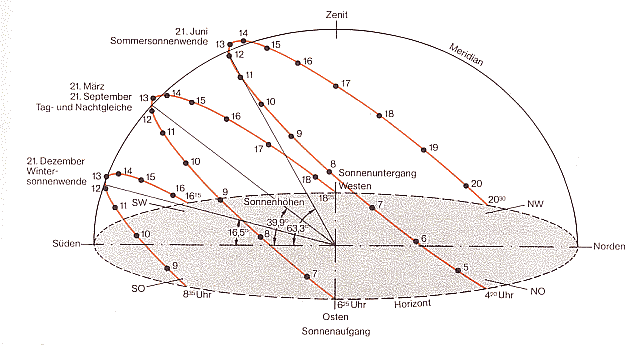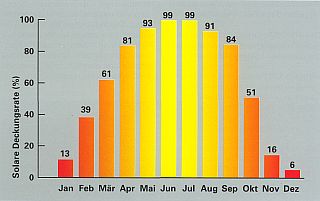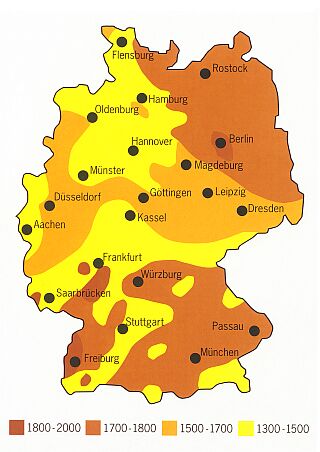Solar Collector?
But we can give you some advice about investing your money in other ways:-)
Contents
- Can a solar collector reduce your heating costs?
- Hot water in summer with the oil/gas boiler
- What can a thermal solar installation achieve in our part of the world?
- System comparison
- Building to get the sun
- Storing the solar gains
- Our alternative thoughts about solar power
1. Can a solar collector reduce your heating costs?
Hot water in summer with the oil/gas boiler
The warm summers of 1999 and 2003 in our mmonitored and optimized system showed very well that is easy to minimize oil consumption for heating hot water, achieving less than 1 litre of oil (10kWh) per day (for an average 2-person family):
| Year | Litres/d | Litres/month | Cost/month | Cost/year |
|---|---|---|---|---|
| (6...9) 1999 | 1.2285 | 38.85 | 7.77 euros | ~ 95 euros |
| (5...9) 2003 | 0.83 | 24.9 | 8.715 euros | ~105 euros |
| Electrical heating in comparison at 0.15 Ct/kWh |
250kWh | 37.50 Euro | ~450 Euro | |
Actual cost of heating water with a low-temperature boiler excluding capital write-off for the months without heating.
Clearly viewable: 4 times more expensive using electrical current for heating!
According to the RWE Construction Guide (11th edition etc.) using a solar panel for heating water in the average house will save between 300 and 1000 liters of oil per year. 1000 liters seems a lot under present circumstances. In other articles describing the potential of heating mains water by solar energy the following figures are quoted again and again:
- You can save approx. 8% of your total heating requirement or 60% of the annual cost of heating mains water.
- For the average family of 4 this adds up to 2500 kWh/a.
- This is the equivalent of 250m³ of gas or 250 liters of oil.
- in 1999: 50 euros (at 20 cents/liter)
- in 2000: 75 euros (at 30 cents/liter)
- in 2002: 87.50 euros (at 35 cents/liter)
Your solar panel will need 53.34 years to pay for itself.
(The figures in the paragraph above were quoted more or less word for word by
'We calculated the material return on investment to be a maximum of 27 months, so that it is always a good investment for the environment.' - You therefore have to add a further 2.25 years' worth of manufacturing costs to your 53.34 years...
What can a thermal solar installation in our part of the world?
- Your gain for a standard 5m² collector per day of summer is about:
10.00 kWh, ie ~1 Liter Öl or ~1 m³ gas ! - Having a giant 20m² collector for heating will give you massive overheating problems in the summer, while only providing approx. 10,000 kWh, ie ~1,000 litres of oil or ~1,000 m³ of gas in a year!
System comparison
With the low consumption of 1 liter of oil per day (talked about above), a 5m² solar panel would be sufficient. Anything over that we need to store longer. The bad news is that even in summer the sun is often covered for several days, an thus supplies no energy, whitch makes it a good idea to design the buffer for 7 days range, i.e. 1500 liters. (Cheaper and normal is 2 days = 300 liters.)A solar energy system cost an average of 4000 euros and can be expected to have a service life of 20 years (240 months). This leaves you with monthly write-off costs of about 16.6 euros. This means that if you use 100% solar instead of oil in summer to get hot water, this is what you pay. If the buffer is empty, the shower will be cold, rather than hot...
Compare this with the cost of hot water from oil given above: 9 euros/month! To make the use of a solar collector system worthwile in the summer (the sunniest period), the current (2003) oil/gas price would have to double.
The most economic-to-run heating systems look unspectacular, are quiet in operation, and will not impress your visitors. A solar collector system will make you the envy of all your friends and will only cost you a lousy 7.60 euros every month. People using electricity for heating are the only ones who are pleased in summer when the solar system returns 20.90 euros during those three sunny months. Some gains at least from a solar system!
Building to get the sun
The diagram below clearly shows how the angle of incidence of the sun's rays and the number of daylight hours changes as the year progresses. Our hope would be that this is present in the mind of all architects so that optimum use is made of solar energy. Example: ![]() Rau achitects.
Rau achitects.

Path of the sun during the year in Germany, ~51º N.Latitude [Source: RWE Bauhandbuch]
2. Storing the solar gains
The basic difference between solar energy and other conventional sources, such as gas or oil, is that solar energy is not 'on tap' (i.e. the sun is not always there to provide it). This means that adding a solar installation to a conventional heating system requires a radical change in energy-storing strategies.
In this case, solar energy should become the basic source of energy, with any required top-up coming from a conventional source triggered by a central heating controller.
Most solar installations without a central controller are unable to store all the solar energy available, and this decreases the benefits of your investment. Devices which are able to charge boilers according to the weather forecast are still under development. This should be possible via the D-channel of ISDN or the internet.
One option is to enable the heater-controlled charging of hot water only at those times when a top-up to solar energy is absolutely necessary, in particular just before those times when hot water is really needed.
[ Contents ]
3. Our alternative thoughts about solar power
In Northern Europe a solar collector system may be a good idea if you are building a new house, but remember the savings you make will outweigh the outlay for the solar investment. Why stick your money on the roof when gas and oil are still affordable, and you already have a heating system which you can run more economically and therefore more environmentally-friendly? With gas and oil at today's prices investing your money will make you more (10%++). In the above example your investment would produce 400 euros a year, nearly enough to fill your oil tank for one year. In 1999 you would have got about 2000 liters.
Our expenditure for heting hot water in 2003 was only 25 l of oil per month with the new boiler. Other users talk about 8 euros per month... Calculate - now!
Do you think we forgot the government grants? - No, but we have to say that in view of the extremely long return on investment period of over 50 years, this would appear to be political madness, just like wide-scale distruction of landscapes in order to install windmills: All 'symbols of green power'.
For these reasons we can detect an intention to mislead in advertising for solar hot water installations: that the important thing is only to sell the consumer expensive uneconomic devices which are also expensive to maintain. So we are waiting for the messiah who will be able to provide proof of the cost-effectiveness of solar hot water installations for those who already have a conventional system installed. Until then, the cost-effectiveness for users living in these geographical latitudes will remain a matter of faith (unless energy prices should increase dramatically, in with case the same users as car drivers would be angry!)
I can only advise you to do as follows:
Prices for oil and natural gas will rise enormously from about 2010, especially when even aggressive states realize that you cannot get oil by bombing...By then at the latest, solar collectors will pay for themselves (even if the price doubles in the meantime). If you are just aboout to build a house and you don't want to have to make alterations (adding new pipes) later for a solar system:
==> Install insulated pipes with an electrical conduit during construction!
This is an expense which every construction budget should be able to bear. Pipes are extremely expensive to install once the house is built. When you have a bit more money, you can install a boiler and a collector with an up-to-date control unit. The scientists are not standing still and will find many new methods for heating less expensively.
Anybody out there with a better idea?
This is what Gunnar Kaestle told us:
'Only buy a relatively small and cheap system with a limited collector surface and a big boiler to supply a large family or a multi-occupied property. Anything bigger will be a waste.
Greetings, Gunnar'
This is also the view of Herr Lindner of ![]() Planungsbüro für Energie & Umwelt (IBL):
Planungsbüro für Energie & Umwelt (IBL):
'What you write about solar systems is confirmed by results of measurements of government-subsidised solar systems.'
Further confirmation from Aribert Peters of the ![]() Energiedepesche:
Energiedepesche:
'... After reading your remarks about return of investment for solar systems I would like to express my agreement.
This is why we at Phönix drastically reduced prices and for self-installers a ready-to go system cost less than 3000 euros net of any subsidy, which changed things a little. After my departure, however, prices increased again so that a minimu of 4000 euros is the investment required.
Greetings from Aribert Peters, Bund der Energieverbraucher - Sat, 18 May 2002 09:48:52'


